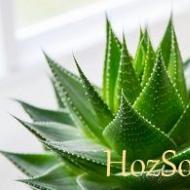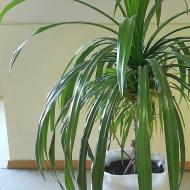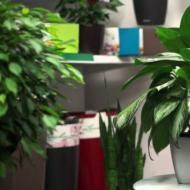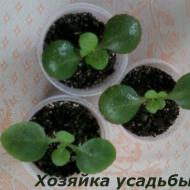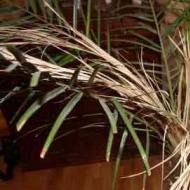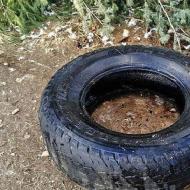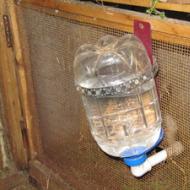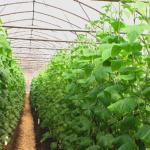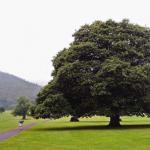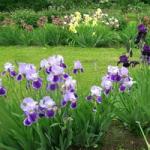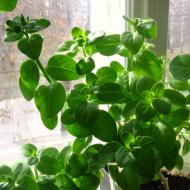
All the secrets of the petunia flower: cultivation, care, types. And more about petunia
The cold weather is approaching, and the petunia on your plot or balcony continues to delight with its lush color. Soon this beauty will come to an end, but it’s a pity... Well, there’s nowhere to escape from the cycle of seasons, but you can try saving petunia bushes for the winter. Petunia, at its core, is a heat-loving perennial, therefore, by creating “southern” conditions for it, we can extend its life. So, now we will reveal the secret of how to preserve petunia in winter.
We hasten to warn you right away: maintaining petunia bushes in winter is not an easy task. Although, this is the best way out if you want to preserve a particularly expensive, luxurious variety that does not produce seeds or does not retain all its properties in its daughter plants. For example, this is suitable for surfinias, supertunias and many other F1 hybrids.
There are 2 options for preserving petunias for the winter:
- in the form of mother plants
- in the form of cuttings
Option #1. Preserving mother petunia bushes in winter
Adult petunia bushes can be preserved until spring if you move them to a bright and frost-free room. It should be light, fairly humid, optimal t = 10-15°C (but even less will do, the main thing is that the temperature does not fall below 0°C). Suitable conditions are found on closed verandas, insulated or southern loggias, and on the windowsills of entrances.
Petunia bushes are dug up, transplanted into pots and brought indoors. You need to have time to do this before frost, that is, in September-November. Dry leaves, damaged and rotten branches are cut off from the plant. Dramatic pruning is also practiced: all branches are cut to 10-15 cm.
 A petunia bush can overwinter on a cold windowsill
A petunia bush can overwinter on a cold windowsill The main conditions for caring for petunia bushes in winter:
- minimal watering (up to 2-3 times a month);
- lack of fertilizers;
- high air humidity;
- temperature 10-15°C;
- good lighting.
In such conditions, petunias survive the winter safely and bloom in mid-February! Then you can “introduce” more frequent watering and fertilizing into the diet.
A petunia bush that has survived the winter is planted in open ground or in balcony containers. Or they do it differently: they propagate petunia by cuttings and grow young petunia plants. The latter option is more common among gardeners. It is believed (and not without reason!) that young petunias bloom better than second-year ones.
 February flowering of second year petunia
February flowering of second year petunia How is petunia cutting carried out?
In the spring, cuttings of 5-10 cm are cut from an overwintered petunia bush - green, not woody. The lower leaves on the cutting are torn off so that a bare stem 1-3 cm long remains at the base. It is important that there is at least 1 pair of internodes in this area. There should be 2-3 leaves left at the top of the cutting. If they are large, then their plates are cut crosswise in half to reduce moisture evaporation.
 Petunia cuttings are planted in loose soil, preferably with baking powder. You can use pure vermiculite or peat for rooting
Petunia cuttings are planted in loose soil, preferably with baking powder. You can use pure vermiculite or peat for rooting The bare part of the stem is deepened into moist, loose soil.
 The leaves of the cuttings can be cut in half to reduce moisture loss through the leaf blades
The leaves of the cuttings can be cut in half to reduce moisture loss through the leaf blades A vapor barrier is placed on top to maintain high humidity around the cuttings. For example, cover the planting container with a plastic cup, glass jar or glass. Every day the “greenhouse” is ventilated to prevent the appearance of mold, rot, and blackleg on the cuttings.
 For ventilation, holes are made in the bottom of the plastic greenhouse glass.
For ventilation, holes are made in the bottom of the plastic greenhouse glass.
After about 10-14 days, young shoots will appear in the axils of the cuttings - this means that rooting has taken place! The greenhouse is removed, the cuttings continue to grow in the same way as petunia seedlings: watered, fertilized, sprayed. Above 5-6 leaves, young plants are pinched for tillering.
 After 2 weeks, new shoots appear in the leaf axils of petunia cuttings
After 2 weeks, new shoots appear in the leaf axils of petunia cuttings How to cut petunia is described in the video:
In March-April (depending on the region), when stable positive temperatures of 10-12°C are established, the rooted cuttings are planted for permanent residence - in open ground or in balcony containers.
 Flowering of petunia cuttings grown from a second-year mother bush
Flowering of petunia cuttings grown from a second-year mother bush Option #2. Preserving petunia in winter by cuttings
In residential premises, rooted cuttings, rather than adult petunias, have a better chance of survival. They do not need special conditions and need to be cared for in the same way as indoor flowers. This method will also help those gardeners who do not want to clutter their verandas, balconies and loggias in winter with large containers with petunia queen cells. Cuttings in cups on windowsills take up very little space!
For winter storage, petunia is cut from late August-September. During this time, petunia propagates easily by cuttings, since the life processes in it have not yet slowed down. 5-10 days after planting, the plants begin to develop roots.
Cuttings 5-10 cm long are cut from petunias, planted in cups, and covered with a “greenhouse”. After rooting, they are placed in a cool, bright place. For example, on a windowsill, closer to the glass. To increase the humidity, you can place a jar of water near young petunias.
 Young petunia cuttings require as much attention in winter as ordinary indoor flowers.
Young petunia cuttings require as much attention in winter as ordinary indoor flowers.
The main conditions for keeping rooted petunia cuttings in winter:
- sufficient watering - after drying the top layer of soil;
- spraying;
- lack of fertilizers;
- increasing air humidity (water containers next to the cuttings).
In spring, cuttings that have already formed into young petunia bushes can be transferred to balcony containers or planted in a flower bed. They can also be cut again and the required amount of planting material can be grown from the new cuttings.
 Overwintered cuttings bloom already with the first rays of the warm sun - in February or early March
Overwintered cuttings bloom already with the first rays of the warm sun - in February or early March Benefits of preserving petunias in winter (cuttings or mature plants)
The main advantages of preserving petunias for the winter:
- early spring flowering. An adult “second-year” plant or cuttings taken from it can bloom as early as February-March. And this will happen even in the northern regions, such as the Urals, Siberia, etc.
- ease of obtaining adult seedlings. To do this, you do not need to sow small seeds or nurse frail shoots. The planted cuttings will already bloom in 2-2.5 weeks.
- preservation of vegetatively propagated petunia varieties until spring.
Petunia is a representative of the genus of herbaceous annual plants, native to hot South America. Belongs to the Solanaceae family. It comes in a wide variety of colors. Petunia blooms all summer and autumn, is not afraid of bad weather and is very easy to grow. Even inexperienced gardeners can cope with its cultivation.
Petunia began to be specially grown back in the 18th century. Many new varieties and hybrids have been developed. Some varieties are suitable for flower beds and borders, others decorate balconies and terraces, alpine slides, and spread like a flower carpet on the ground. Depending on the size of the flowers and appearance, all varieties of petunias are usually divided into several groups:
- multifloral petunia
- grandiflora petunia
- floribunda
- ampelous.
Multifloral petunia
These varieties have a huge number of small flowers with a diameter of 7 cm. The buds grow very densely and almost completely cover the bush. It begins to bloom early and blooms until the first cold weather. This is a fairly unpretentious plant, rain and sun. Blooms profusely. The colors are both variegated and monochromatic. These petunias are compact and quite low; they are used to decorate flower beds and borders in the form of a carpet flower bed. They are also often cut, turning them into a flower ball. Varieties of multi-flowered petunias that are often grown are the following:
Snowball. Variety with white flowers. Height 30 cm, bud diameter 5 cm. Blooms in June and continues to bloom until the first frost. A variety of flowers that is resistant to many vagaries of weather.
Alderman. Height 30 cm. Diameter of blooming flowers 5 cm. Dark blue flowers. It blooms from June until frost.

Debonair F1 Black Cherry. Hybrid American variety of petunia. Grows 30 cm tall and wide. Flowers with a diameter of 6–7 cm are burgundy with black tints. Plants bloom continuously.

Duo Summer. Terry multi-flowered petunia with spreading bushes 20 - 30 cm. Small leaves, 7 cm buds. Pink flowers. Blooms from June to the end of September.

Large-flowered petunia (grandiflora)
The most common group. Unlike the first petunia, the large-flowered variety has larger flowers, but there are fewer of them. It does not tolerate bad weather well, so they prefer to grow it on terraces or balconies. The following varieties are popular:
Parade corduroy. Hybrid 25 cm in height. The flowers are burgundy-red.

Sonata. Snowy white flowers 12 cm in diameter, simple flower shape.

Pink sky. The flowers are bright pink. Large buds.

Picoti. Height 30 cm. Flowers 7 cm. Color can be red, crimson or blue with a white border.

Ampelous petunias
They are distinguished by long, falling shoots, densely covered with buds. Ampelous petunia has its own peculiarities.
- The length of the growing shoots is from 30 to 120 cm. They fall down, so it is preferable to grow them in hanging pots.
- The size of petunia leaves depends on age; the older, the larger.
- Flowers are formed along the length of the shoot. They have a bell shape.
- One plant can produce buds of different colors and sizes.
- Rich color palette. The petals are most often two-colored. The inside is brighter. People like to decorate balconies, terraces, and pillars with hanging plants. Blooms from June until frost.
There are many varieties of ampelous petunia. The popular ones are:
Black velvet has an unusual color. 25 – 30 cm, large flowers 8 cm in diameter, black velvety color.

Mashenka– a densely branched variety, the length of the released shoots is 80 cm, the flowers are funnel-shaped, 6 – 7 cm in diameter. Color pink, yellow center.

The Snow Queen is a hybrid, its shoots reach 80 cm. The flowers are snow-white with a pleasant smell.

Explorer widely spread. Wide variety of colors. Stems 1.5 meters. The flowers are large, with a waxy structure, which allows them to withstand bad weather.

Floribunda
Petunia floribunda falls between multi-flowered and large-flowered petunias. Tolerates bad weather well. Flowers 10 cm. Floribunda looks best in mass plantings. Grows well in both sun and shaded areas. Popular varieties:
Sonia– a series that includes 11 varieties. The plant is 25 cm, the bush is very compact. Flowers with a diameter of 8 cm, the color can be different: purple, white, red, pink. Can be two-color.

Milky Way– petunia with shoots 25 cm. Snow-white flowers with a pink star inside, reaching 10 cm. They begin to bloom in May and until the end of autumn frosts. They withstand the vagaries of the weather well and do not lose their shape after rain.

Angora– a hybrid variety, with erect shoots up to 45 cm in height. Blooms from early June until frost. The flowers are 7 cm in size, with wavy edges, double. Pink color.

Celebrity– a series of hybrids includes 13, both single-color and multi-colored colors. Plants resistant to rain and cold, no higher than 30 cm. There are many small buds on the shoot. It is better to plant in groups.

Growing petunia seedlings
To get strong and high-quality seedlings, you need to be careful when choosing containers and soil. The seedling boxes should be made of wood, plastic or ceramic. Containers should be wide and of medium depth. Drainage holes are required. You can use plastic disposable food containers.
It is necessary to put drainage at the bottom of the container. You can use expanded clay, pebbles. You can buy special drainage at a flower shop. This is necessary so that air passes to the roots and water does not stagnate in the soil.
Then the seedling containers should be disinfected. You can use Formalin or a solution of potassium permanganate. After processing, the container should be thoroughly rinsed with water. If seedlings are planted in a wooden box, a layer of paper, preferably thick paper, should be placed on the bottom.
Seed selection
Petunia seeds are sold in two types:
- in granules;
- in bulk.
Seeds in granules are more convenient and have good germination. It is worth deciding on the timing of sowing them for seedlings.
It should be remembered that two months pass between sowing and the first flowers. They begin to plant seedlings from the second half of February until mid-March. This depends on whether it is possible to provide the seedlings with additional lighting, since there is still insufficient daylight in February.
For petunia seedlings, neutral or slightly acidic soil is needed. It should be a nutritious mixture, loose, that retains moisture, but does not get wet. You can purchase the mixture in the store. Universal ready-made substrate Stender. For 5 liters of Stender you should also add half a liter of ash, a large spoonful of potassium sulfate, 250 grams of perlite and mix well.
Another option for the mixture: part garden soil, part sand and two parts peat. Stir, sift through two sieves of different sizes and pour over a strong solution of manganese. Or use the Previcura solution.

Drainage is poured into the bottom of the container, then a 6 cm layer of earthen mixture is added. There should still be at least 3 cm left to the end of the sides. Petunia seeds are very small and difficult to sow. Granulated seeds are more convenient. They can be taken with tweezers and placed on the ground in rows.
The seeds are not deepened; they are simply sprinkled with a two-millimeter thin layer of soil. If you use loose small seeds, you can sow them in three ways:
- use of sand;
- use of snow;
- using a toothpick.
The first method is to mix the seeds with sand and spread them over a substrate that has been watered in advance. The crops are slightly moistened on top using a spray bottle and sprinkled with a millimeter of soil. You cannot use a watering can, as such watering will greatly deepen the seeds into the soil.
The second method involves sowing petunia seeds on a thin layer of snow, laid in a 1 mm thick layer on the surface of the substrate. Seeds are poured onto the snow and distributed over the entire surface using tweezers. When the snow melts, it will draw the seed material to the required depth and moisten the crops. And you won’t need to water or sprinkle soil on top.
The third method of sowing is using two toothpicks. The seeds are poured onto a white sheet of paper. Pick up the seed with one toothpick, with the tip moistened with water, and shake it off with another toothpick, moisten it on top and sprinkle it with substrate.

Having finished sowing, cover the containers with transparent material and take them to a warm room where there is enough light. With a temperature of 25 degrees.
Seeds can be planted in special seedling cassettes. You can select by the number of cells. A cassette with cells is useful for repeated use, and the seedlings in them do not need picking. Experts advise choosing fairly spacious cells with a height of 10 cm.
The cells are filled with substrate. Caring for sprouts in cassettes is the same as caring for seedlings in regular boxes. Some gardeners plant seeds in special peat tablets. It is easiest to plant pelleted seeds in them. You need peat tablets 4.5 cm in diameter. They are placed in water to soak. Next, excess liquid is removed, and the tablets are placed in a container with high edges.
You can use cassettes. Place one seed in each tablet and water it with a pipette to soften the seed shell. When the shell gets wet, you should smear it with your fingers so that the seed germinates faster. The plantings are covered with transparent material.
It is believed that such seedlings are easier to care for; they do not need to be replanted and it is easy to understand when they need watering. In addition, with this method, the germination rate of petunia seeds is much higher.

Seedling care
If everything is done correctly, the first shoots will be visible in a week. Care for flower seedlings is very important:
- watering;
- feeding;
- lighting;
- temperature regime;
- dive;
- topping;
- control of diseases and pests.
Watering
Petunia seedlings need moderate humidity. The soil should not be wet. This can lead to rot and disease. But overdried soil is also detrimental to seedlings.
Young plants need drip watering. For watering, use a syringe or pipette, pour at the root, do not get on the leaves. You can pour water over the wall, or use a tray for watering. Water for irrigation needs to be settled, at room temperature, or slightly warm.
Two minutes before watering, add lemon juice to the water. Water the flowers, depending on the weather. If the day is sunny, water in the evening. If the weather is cloudy, then watering is carried out in the morning.

Top dressing
Feeding young plants is also very important. It is recommended to apply fertilizers systematically. In the first two weeks, you will need to spray the petunias with a weak solution of potassium permanganate or Pervikura. After the appearance of the fourth leaf, the plants are fertilized with a solution of yellow “Kristalon” in the amount of half a tablespoon per 5 liters of water.
Fertilizing can be done either by foliage or by adding fertilizer to the soil. For foliar feeding, use “Kristalon” and “Uniflora micro”. Seedlings are fed three times a week, using two methods alternately. After picking, it is recommended to use fertilizers that stimulate root growth. Such as “Aquarin”, “Solution”, “Plantofol”. Everything is prepared according to the instructions.

Temperature
Petunia seeds germinate at 25 degrees. If the temperature is low, the seeds simply will not sprout, and if it is higher, the plants can become very stretched and begin to hurt. After the shoots appear, you will need to open the plants twice a day, starting at 20 minutes.
The covering is completely removed when the plants grow to it. The temperature is reduced to 20 degrees during the day and to 16 at night.
Lighting
Flowers need lighting almost around the clock. Good lighting allows young plants to grow well and speeds up the flowering period. The duration of the required daylight hours is 12 hours. The lighting is turned on in the morning at 7 o'clock and turned off in the evening at 22 o'clock.
Additional lighting is installed at a height of 20 cm from the seedlings. For this purpose, LED, fluorescent, and phytolamps are used.

Picking
Picking seedlings is carried out only if they grew in common boxes. For picking, select 250 ml cups with holes for drainage. When the shoots are 5 cm in height, begin picking.
- Using a sharp garden knife, plant the plants to a depth of 3 cm. The knife is inserted at an angle of 45 degrees. It turns out that by pinching off a piece of the root, the development of the root system is stimulated.
- The flower is placed in a separate container.
- Add substrate to fill the voids. Watered.
- The temperature is reduced by three degrees for a week, and sunlight is avoided.
- You can feed only after a week and a half.
If the seedlings are grown in tablets, then the seedlings can be planted in an individual container along with it.
Pinching
Pinching is done for all varieties of petunias, except for hanging varieties. It consists of removing a piece of the stem at the 4th and 5th leaf along with the growing point.
Young shoots will emerge from each leaf axil, and in the future such plants will bloom profusely. After half a month, a second pinching is carried out. To get a lush bush, pinching must be done several times.
Improper watering and excess moisture can lead to blackleg disease. A dark spot forms at the base of the shoot, the tissue underneath becomes soft and rots. A constriction forms and the plant falls.
All diseased seedlings must be destroyed, and the soil must be watered with a solution of potassium permanganate or Formalin.
Often, due to excess moisture, petunia seedlings may experience iron deficiency. In this case, iron chelate, which is contained in the Ferovit product, should be added to the soil. Conversely, excessive dryness leads to the appearance of spider mites, which settle on the leaves. For the fight, special drugs are used: Neoron and Fitoverm.
Petunia transplant
When, after the picking, the seedlings take root and begin to grow, they begin to prepare them for planting. The plant is hardened for two weeks and accustomed to fresh air. Start with 15 minutes outdoors. And just before planting, flowers should be exposed to the air around the clock.
Flower planting begins from the second half of May until mid-June. Petunia is a fairly unpretentious plant, but still prefers sunny areas. Prefers loamy, fertile soil. The soil is dug up, humus or compost is added, and weeds are removed.

Flower seedlings are planted when there is no sun, or in the evening.
The holes should be ten cm deep. The distance depends on the selected variety. Between large-flowered ones - 23 - 25 cm, between small-flowered ones - 18 - 20 cm. Ampelous ones are planted 28 - 30 cm from each other. Before planting, seedlings are watered for better removal from containers.
To avoid damaging the roots, plant them together with a lump of earth. After planting, the flowers are watered, and the soil nearby is mulched with humus or peat. Petunia should be protected from strong sunlight for several days. This can be done using canopies made from cardboard boxes.
Flower care
Care consists of:
- in timely watering;
- in systematic feeding;
- in the picking of withered flowers.
Petunia should be watered only in dry weather, preferably in the evening. The plant does not like excessive humidity and when water stagnates in the hole. It is enough to simply moisten the soil around the roots a little. The next day, the ground is loosened so that a crust does not form, and the weeds are removed.
The beauty and duration of the flowering period of petunia depends on regular feeding. After 10 days, the plant is fertilized for the first time. Use nitrogen-containing fertilizers. Nitroammophoska has proven itself well.

During the formation of buds, potassium salt and superphosphate are used. You can use wood ash from a fire. If the leaves begin to turn yellow and fall off, the plant may have developed chlorosis. This means he lacks iron. In this case, Ferovit will help. They spray petunia 3-5 times with a period of three days.
Flowers that have bloomed are removed. This pushes the plant to form new buds and prolongs flowering. Using the pinching procedure, the bush is given a beautiful shape.
You can make a bush in the form of an unusual flower ball with many blossoming buds.
We collect seeds
If you need petunia seeds for seedlings next year, you should select several lower buds on the bushes of the selected varieties. The process of seed formation in these buds is faster. After 60 days from the formation of buds, the seeds will ripen.
The capsules are cut off, the seeds are poured out and stored at room temperature. Each box contains about one hundred seeds. They are very small, about half a millimeter. Then the seeds ripen at home for four months. They do not lose their viability for about four years.
It is best to distribute the seeds into bags and label which variety so as not to confuse them.

Pests and diseases of flowers
Petunia is a fairly hardy plant, but it is still susceptible to disease and is loved by insect pests. Diseases to which you are susceptible:
- Powdery mildew is a common fungal disease that affects both leaves and buds. Spreads from bottom to top. A white coating, starting from the leaves, covers the entire plant. The leaves dry out and curl.
- Gray rot is also a fungus that can destroy a plant in a few days. Brown spots appear at the bottom of the petunia, then they dry out and become covered with a fluffy coating. The entire plant is affected.
- Blackleg is a disease that can spread from one seedling to another. The stem at the bottom of the plant darkens and rots, and the plant falls away from the root. The disease can destroy all flowers.
To combat these diseases, it is recommended to treat seeds, destroy diseased plants, maintain a watering regime, prevent soil acidification and use preparations such as “Skor”, “Bravo”, “Topaz” to combat powdery mildew. For gray rot they use “Trichodermin”, “Integral”, “Skor”. From the black leg "Trichodermin".
- Spider mite colonies form sticky webs on plants. White spots form on the leaves and increase in size. The leaves dry out and fall off. The parts of the plant on which the aphids have settled become covered with sweet dew, then a sooty fungus appears. The leaves curl. Aphids cause viral diseases of petunia.
- Thrips are small insects that live on leaves. The buds become deformed and the plant withers.
Chemicals that are sprayed on plants will help against pests. Such as: “Spintor - 240”, “Confidor”, “Aktar”.
Petunias are beautiful flowers with a delicate aroma. There are a large number of colors that you can choose to suit every taste. Starting from snowy whites and ending with exotic blacks. And also pink of all shades, purple, red, blue, multi-colored and many others. And most importantly, petunia is an unpretentious plant, a little knowledge, a little work and the flowers will delight you throughout the summer season.
Petunia (petunia) (lat. Petunia) is a perennial or annual, herbaceous or subshrub flowering plant that belongs to the class Dicotyledons, order Solanaceae, family Solanaceae, genus Petunia.
The first name of petunia Nicotiana axillaris appeared thanks to the French naturalist Jean Baptiste Lamarck, who discovered and described this plant in 1793 during a scientific expedition to South America. This small error arose due to the similarity of the leaves of these plants with tobacco leaves. When, ten years later, several more species similar to Nicotiana axillaris were found, they were separated into a separate genus, which was named Petunia from the Brazilian word “petun”, meaning “tobacco”. The Russian definition of the plant “petunia” appeared as a result of a free reading of the scientific name of the flower.
Features of petunia
The shape of petunia is bushy. Such a flower can reach 0.15–0.7 m in height; its densely branched shoots can be erect or creeping. Alternately arranged solid oval leaf plates reach 5–12 centimeters in length, they have a dark green or green color. There is pubescence on the surface of the foliage and shoots. Single funnel-shaped flowers are located on short peduncles; they can be irregular or regular, terminal or axillary, double or simple, and also fringed. The flowers can be purple, pink, blue, pale red, white and violet, with a border, a whitish star, a halo or dark veins. The fruit is a two-leaf capsule containing seeds inside.
On balconies and garden plots, varieties of garden petunia (hybrid) are cultivated, which were bred using wild species of axillary petunia and violet petunia. Flowering begins in July and ends with the onset of frost. Perennial petunia is always grown as an annual plant.
Where does petunia grow in the wild?
The natural habitat of petunias includes Brazil, Bolivia, Uruguay, Paraguay and Argentina. One of the species is found even on the North American continent. In the warm climate of these countries, petunias are perennial. Due to their beauty and variety of shapes of bushes and flowers, petunias have become popular among gardeners. Today, these flowers are cultivated in the countries of Western, Central and Eastern Europe, including throughout Russia, as well as in Central, Middle and South-West Asia. In cooler climates, petunias are grown as annuals. In addition, in many countries around the world, petunias are favorite house flowers that grow in pots on windowsills, in boxes or hanging vases on balconies. 
Types and varieties
All varieties of petunia are divided into:
- bush forms, which, in turn, are divided into large-flowered and small-flowered plants;
- ampelous;
- cascading.
Despite the fact that this plant has been known to scientists for more than 200 years, there is still no scientific classification of petunias. While botanists were engaged in heated discussions about the specific name of the plant and whether it belonged to a particular species, breeders were working on creating completely new species of these flowers with many subspecies and hybrids.
Today there is reliable information about 21 species of petunias that grow in the wild:

Petunia hybrid
Obtained from crossing different natural forms of the plant. It is a perennial, but is usually grown as an annual crop.
The plant is bushy, branched, up to 60 - 70 cm high; additional splendor is achieved by maintaining stepsons on the bush. The flowers are single, can be: simple, double, with a corrugated edge, up to 12 - 15 cm in diameter. Blooming petunia spreads a pleasant, unobtrusive aroma. Flowering is abundant and lasts from late May until frost.
There are several forms of hybrid petunia.
- Multi-flowered form. The most unpretentious group of plants, forming a lush bush, abundantly covered with medium-sized (3 - 5 cm in diameter) simple flowers. Petal color: white, pink, red, lilac, purple, there are two-color varieties. Varieties:
Snow globe (a bush, 40 cm high, abundantly covered with snow-white simple flowers);
Alderman (the bush reaches a height of 30 cm, the flowers are deep blue, up to 5 cm). - Large-flowered form. The group is represented by rather capricious plant varieties, but is considered the most beautiful. The diameter of flowers of different corolla shapes reaches 13–15 cm. Only a few buds bloom at a time on a bush, but their size and shades are amazing. Varieties:
Triumph (the diameter of double flowers of various shades reaches 15 cm);
Pikoti (plant height 30 cm, colors - crimson and red, blue with white edging, corolla size 6 - 8 cm);
Pink sky (bush height up to 30 cm, large, bright pink flowers). - Floribunda. A successful hybrid that combines the abundance of flowers and unpretentiousness of multi-flowered petunia and the beauty of large-flowered petunia.
Ampelous petunia
The flower is characterized by the formation of long shoots covered with flowers that hang down. A rather demanding plant in terms of heat, nutrition and moisture. Used to decorate balconies and walls. Ampelous forms of petunias are planted in hanging flower pots and flowerpots. Varieties:
- Ramblin - a group of multi-colored varieties of ampelous petunia, with large flowers and shoots 80 - 90 cm long;
- Wave - the length of the shoots of these varieties reaches 120 cm, the flower size is up to 7 cm, the color is violet, purple, blue, pink;
- Avalanche - large-flowered (up to 9 cm) ampelous petunia with shoots 70 cm long;
- Opera Supreme is an unpretentious ampelous form that forms a lush bush, with small (up to 5 cm) blue, crimson, white or pink flowers.
Cascade petunia
The plant is often confused with the hanging form. The difference is in the shape of the bush. In cascading petunia, the shoots first grow upward, then, under their own weight, fall down. The shoots of the plant are shorter and thicker than those of ampelous petunia. Varieties:
- Orchid mist is a large-flowered cascading petunia with white and pink double flowers;
- Pirouette - double flowers of various colors, varieties are unpretentious;
- Gioconda - the diameter of numerous flowers does not exceed 6 cm, their color: white, pink, purple, orange, scarlet;
- Tornado is an unpretentious group of varieties, with large (up to 7 cm) flowers and shoots more than 100 cm long;
- Burgundy is a profusely flowering variety with large double flowers of purple or deep blue.
- Surfinia is a petunia that does not belong to the ampelous or cascading forms. The length of its shoots reaches 200 cm, they are covered with large flowers of different colors.
Having looked at the presented photos of flowers, you can truly appreciate the beauty of petunia.
Growing petunia from seeds

Sowing
If you sow petunia seeds for seedlings in February, they will need lighting. Most gardeners prefer to sow seeds from mid to late March, but it should be taken into account that due to insufficient daylight hours, seed germination is extremely low, so they must be sown with a reserve. The substrate for sowing should be light, loose and rich in nutrients. Recommended substrate composition: rotted humus, peat, sand and turf or leaf soil (2:2:1:2).
Fill the container with the soil mixture, the top layer 10 mm thick should consist of sifted substrate. 24 hours before sowing, the soil mixture must be thoroughly watered, in this case the seeds can be distributed evenly over its surface. Seeds must be mixed with dry sand before sowing. Then they are evenly distributed over the surface of the substrate and moistened with a spray bottle. The top of the container must be covered with film or glass. Crops are harvested in a warm (20 to 23 degrees) place.
After approximately 7 days, the first seedlings should appear. They will need to be ventilated and moistened with a sprayer every day, 2 times a day. It is very important to maintain a high level of air humidity in the mini-greenhouse during this period, however, because of this, “black leg” may develop on the plants. To prevent this, it is necessary to remove condensation from the film every day immediately after it appears, and the glass must be turned over to the other side. In addition, the seedlings must be systematically sprayed with a weak solution of potassium manganese. When the plants have formed their first true leaf blade, the cover from the container will need to be removed, the surface of the substrate should be covered with a thin layer of sand, and watering should be reduced.
Seedling care

When the seedlings have formed 3 or 4 true leaf blades, they should be picked, first thoroughly moistening the substrate in the container. Take a stick and carefully pry it over the plant. Pull it out of the soil by grasping the leaves, while trying not to shake the substrate from the roots. For picking, use individual plastic or peat pots, which must be filled with the same substrate. After the plants are picked, they need to be watered well and covered with paper sheets or lutrasil for 2-3 days.
During this period, seedlings need to be cared for correctly and this should be taken seriously. During this period, the substrate should be moderately moist at all times. At this time, the frequency of watering is influenced by a variety of factors, so in one case the seedlings will need to be moistened 1 or 2 times every 7 days, and in the other - twice a day. It is very important to systematically loosen the surface of the substrate around the plants. 7 days after picking, the plant will need to be systematically fed once a week, and the root and foliar feeding methods should be alternated. For feeding, you can take Kemira, Nitrofoska, Mortar or other water-soluble complex fertilizers, with 25 to 35 grams per bucket of water.
Grandiflora varieties begin to bloom 3 months after sowing the seeds, and multiflora varieties - after 2.5 months. Before you start planting seedlings in open soil, it must be hardened off. To do this, the seedlings are taken outside during the daytime or the seedlings are transferred to a cool room for several days.
Seed collection

Seeds should be collected only after they have fully ripened on the bush. During the flowering period, you should mark the bushes of those varieties from which you will need to collect seeds. It should be noted that the lower buds are used to collect seeds, because in them the seeds form and ripen faster. After the bud is fully formed, you should wait 8 weeks; after this time, the seeds in them will fully ripen. The seeds of such a plant are small (diameter approximately half a millimeter), there are approximately 100 of them in one box.
Shake the ripened seeds out of the boxes and distribute them into bags, do not forget to label the year of collection, variety and color of the flower. You can also simply cut the boxes and place them in storage at home. The seeds need to be ripened; to do this, they are stored at room temperature for 3–4 months. If the seeds are stored correctly, they remain viable for up to four years.
After flowering
If you want to preserve petunia, it should be removed from the soil in October, then all shoots should be removed from the bush. The bush is planted in a pot and put into a cool room. Here the flower will rest, but it needs to be watered occasionally to keep the ground moderately moist. The pot with the plant should be moved to a well-lit, warm windowsill in February, and systematic watering should be resumed. After the young stems have formed 2 or 3 pairs of leaf blades, they must be cut off with a “heel”, which are planted in flowerpots filled with nutritious soil, its surface should be covered with a layer of sand. The container must be covered using glass or film, then it is transferred to a small shade. Provide the plants with regular watering, spraying and ventilation for 20 days until the shoots take root. Then the plants are transplanted into separate cups. They are planted in open soil at the same time as petunia seedlings.
In the autumn, unnecessary faded petunia bushes should be dug up and burned, and the area should be dug up.
Features of flower care
Nothing special needs to be taken care of:
- timely watering;
- loosening the soil;
- removal of weeds.
Planting petunia in open ground
As already mentioned, seedlings are planted in open ground hardened and after the onset of stable heat. There is an important feature - compost or humus must be added to the holes before planting the seedlings.
It is impossible to use pure manure, since not only can the root system of the seedlings burn out, but along with the manure various bacteria will enter the soil, which can lead to flower disease.
Small-flowered petunia is planted at a distance of 15 cm from each other, and large-flowered petunia at a distance of up to 30 cm. When planting flowering flower seedlings, you can be sure that if they are properly cultivated, they will bloom until the first frost.
Any planting of seedlings is best done on cloudy days. If these are not expected, then it is worth planting in the evening with the setting sun to facilitate the survival of the seedlings.
Place for a flower bed
In order for the flower to develop well, before planting it in open ground, you need to choose the right place where the flower bed with the planted seedlings will be located. The place can be completely sunny or with light shade from the crown of a tree. Any soil will do, as long as there is no stagnation of moisture. Blooming petunia will look very beautiful near rose bushes, while at the same time scaring away various pests from it. 
Watering
The flower likes moderate watering, but does not like bays that lead to waterlogging of the soil. The flooded flower wilts and may no longer return to normal. Watering time is either early morning or evening after the sun drops below the horizon. When watering at midday, the flower will get burned and die, as it will not be able to absorb oxygen from the affected leaf plates.
During prolonged rainy periods, petunia planted in a hanging pot may die from excess moisture, so the pots are removed and brought under the canopy of the veranda.
When watering the flower beds, you must try not to get on the flowers, since in this case they will lose their appearance and the bush will look disheveled and you will have to wait for new buds to bloom.
Feeding bushes
Feed the flower plantings once a week alternately with organic fertilizers and mineral fertilizers. The vegetative mass of the plant develops very well if it is occasionally watered with humate.
pruning
Only bush petunias are pruned, after which the bushiness of the plant increases. Ampelous and cascading ones do not respond to pruning, continuing to grow with one lash.
Seed collection
The most important thing here is not to miss the ripening time of the flower’s seed capsule. When the box is fully ripe, it opens and the seeds scatter around the mother plant. Therefore, half-ripe boxes are cut with scissors, placed in cardboard boxes and the flower type is labeled. Store at room temperature indoors for about 4 months, during which they will ripen. Seed germination lasts 4 years.
To choose the right quality plant seeds in the store, you need to pay attention to the fact that high-quality seeds are packaged in bags of 5 pieces. The price of good seeds cannot be the cheapest.
Petunia propagation by cuttings
Beautiful hybrid varieties of petunias, reproduced only by cuttings. To propagate the plant you like, it is important to know the rules for growing seedlings from cuttings. In March or April, when it is best to carry out cuttings, cut off the ends of young shoots with 2 or 3 internodes. The cutting should be 5 or 6 cm long. The lower leaves of the cut shoot are removed and planted, buried 2 or 3 cm in a box with prepared soil. The soil should be light - 50% peat, 25% sand and 25% fertile turf soil. It is advisable to sprinkle 1 cm of dry sand on top.
The end of the cutting is dipped in Kornevin before planting. Water the cuttings with clean water and a weak solution of potassium permanganate. After 2 weeks, the cuttings will take root and then they need to be planted in separate containers. Petunia flowers will decorate your front garden, loggia or flower bed with abundant blooms. Many varieties bloom all summer and are pleasantly fragrant. You can choose any color of flowers to create a beautiful decoration for your garden or room. 
Pests, diseases
Petunia is a delicate plant that is affected by a number of ailments.
- Powdery mildew spreads during damp and cold summers. At risk are densely planted plants that receive watering not at the roots, but at the foliage. A fungal disease is manifested by the appearance of a whitish coating on the leaves and stems of the plant.
The affected parts of the plant are removed, densely planted bushes are planted. Petunia is treated with Topaz solution or another similar fungicide, spraying the plant generously. - Blackleg. A frequently occurring fungal disease on flower seedlings. Brown or black constrictions form on the stems of young plants, at soil level. The bush falls and dries up.
The fight against blackleg consists of prevention: watering the seedlings only with warm water, with the addition of potassium permanganate crystals. After watering, the soil is loosened, sprinkled with dry calcined sand or sifted wood ash. - Late blight. The disease occurs on weakened plants during cold nights and growth. At the first signs of the disease, petunia is sprayed with Profit and Ridomil. Preventive treatments with garlic infusion or whey solution will help.
A strong and robust plant has good immunity and is able to resist pathogens. By providing the petunias with enough light, nutrition and moisture, the gardener will not have to treat the plants.
A number of pests are not averse to feasting on the flower.
This the plant loves loamy soil, but also takes root well in ordinary garden soil, and some varieties even in simple soil. But it is best to grow this beauty in fertile soil, which consists of peat, turf, river sand, and leaf soil. Another excellent option for growing is adding nitrophoska to the earthen substrate.
In garden soil, the greenery of the plant becomes juicier and its growth accelerates, because... they really like a slightly acidic environment.
Growing petunias requires special light conditions. She prefers well-lit areas for growing, however, in the scorching sun, flowering may fade. Small shading is also needed.
Lighting is one of the main conditions for growing petunias. Therefore, well-lit, shaded areas are ideal.
The soil in which petunia grows should be moist, but not flooded. Excess moisture will stop its growth. It is also important to ventilate the soil in which the plant grows. Growing these flowers is not difficult if you simply follow the conditions of lighting, watering and soil composition.
Is it possible to grow the plant at home?
Can this plant be grown indoors? Yes, but it's more complicated than .
Note! The most important thing is that the soil in the growing container should be light and moisture-absorbing.
Therefore, great attention must be paid to the soil. To do this, it will be enough to mix simple garden soil with purchased peat-based soil. You can also plant in purchased soil, but first add hydrogel to it. The hydrogel must be prepared in advance. It should also be taken into account that such a substrate retains moisture for quite a long time and you need to be extremely careful with watering the plant. Water only when it dries out, especially for newly planted plants.
Growing petunias in a pot or container also means choosing the right container for growing. Bush and terry petunias need 3 liters of soil per plant. This means you can plant 3 plants in a ten-liter container. Large containers retain moisture longer, so it is better to plant several plants in one large container. But ampelous, cascading petunias and sufinias need 5 liters per plant.
The container must have holes to allow excess moisture to drain out. If you choose the wrong container, then you can achieve beauty, but not for long. Petunias will first thrive and then survive in these conditions. And they will not delight you with long and lush vines and abundant flowering. We discussed what other reasons can lead to the absence of flowers and how to eliminate them.
It is important to remove faded flowers from the plant. Secrets of growing petunias:
- Selecting a location– this should be a well-lit place with slight shadows.
- The soil- both ordinary garden soil and specially prepared using purchased peat-based soil, with the addition of hydrogel, turf, and coarse sand.
- And– water every day, especially if you see that the top lump is dry. It is best to water in the morning and evening. Petunia does not like stagnant moisture, so take care of good drainage. Feed regularly with mineral fertilizers. The main thing is that it contains potassium and phosphorus - they are responsible for the development of flower buds.
Reproduction methods
You can propagate in two ways: growing seedlings from seeds and cuttings.
This is the most common way to grow a plant, including at home. Buy seeds in a shell - they are easier to plant and are much larger. To begin with, we prepare the soil and maintain the desired temperature of 22-25 o C. We plant it in a container that must have drainage. Before planting, disinfect the drainage with a weak solution of potassium permanganate. Carry out the same procedure with the soil; use special preparations to disinfect it.
Sow seeds in slightly moist, but not soggy soil. Before this, it is better to mix the seeds with river sand. Next, cover the container with the seeds with glass or film. We grow seedlings at a temperature of 22 o C. To prevent the soil from becoming soggy, constantly remove condensation from the glass or change the film.
On a note. Don't forget about good lighting. As soon as small bushes appear and the roots become stronger, you can either continue growing them in a greenhouse.
Watch a video about growing petunia. Sowing seeds for seedlings:
By cuttings
It allows you to grow the plant much faster. It assumes the presence of an already mature plant. To do this, cut off the side shoots of the petunia. Then The cuttings are disinfected and planted in small cups with light soil. We put it in a shaded place. Do not forget about moistening the soil and fertilizing with mineral fertilizers. This way the plant is prepared for winter. In spring we plant them in open ground.
Watch a video about propagating petunia by cuttings:
Planting kit
- Priming.
- Container for planting.
- Disinfectants.
- Seedlings for planting.
- Drainage.
- Mineral fertilizers.
Cultivation

In greenhouses
- Sowing seeds– we purchase seeds in a special store. We purchase or prepare the substrate ourselves. It consists of peat, sand, and earth. Wipe everything well and pour in a solution of potassium permanganate. The wet mixture sits in boxes for several days. Before filling, boxes are sterilized with peroxide or potassium permanganate; peat is spilled with fungicides before sowing. The seeds are sown in peat, the peat layer in the box is 2-3 cm and consists of small particles, well sifted and even.
Important! The seeds are not covered with soil so that light falls on them. We also provide additional lighting.
We germinate at a temperature of 22-25 o C. The required air humidity is 95-98%; to maintain it, we cover the crops with glass or polyethylene. The substrate should not dry out, so we often water it with a sprayer. The water should be settled slightly warmer than the substrate. After germination, reduce the temperature to 18-20 o C.
- Picking– move the plants into cups. Stay in them until the roots take up all the space. At first the cups are side by side, but as the seedlings grow they are spaced apart.
- Watering and feeding– when seedlings are planted, you need to ensure that the top layer of the substrate dries out before the next watering. Therefore, water the cups once a day or less. It is better to water in the morning and evening. We combine fertilizing with watering.
Rules of care
Petunia will not require much effort on your part. It is enough to simply control the watering and feeding of the plant. You need to water at the root of the plant so as not to damage the delicate flowers. The day after watering, you need to loosen the soil so that a crust does not form. Remove weeds. Feed a week after planting in the ground. We combine watering and fertilizing. We feed with fertilizers with potassium.
Problems, diseases and pests
Sometimes you may encounter a problem such as yellowing or drying of petunias. If you do not follow the rules of care, the plant may get sick:
- late blight;
- chlorosis;
- black leg;
- gray rot.
They need to be dealt with with special drugs. But it’s easier to prevent their appearance with proper care. If these rules are not followed, then in addition to these diseases, petunia can be affected by viral diseases. There is no cure for them - your plant will die. Among the dangerous pests are spider mites, aphids, slugs and thrips.
Follow simple rules for caring for petunias, then you won’t have to worry about the health and beauty of your plant. It will always delight you with beautiful blooms.
If you find an error, please highlight a piece of text and click Ctrl+Enter.
| 1. Growing temperature: during the growing season they keep petunia at a temperature of 18 to 25 ° C; in winter it is advisable to place it in a cool place with a temperature of about 13 - 15 ° C. |
| 2. Lighting: brightly lit location with shading from direct sunlight in spring and summer during the daytime. Plants can be sunbathed for 4 hours daily to initiate flowering. When grown in partial shade, flowering will be less abundant. |
| 3. Watering and air humidity: with well-settled water at room temperature, in spring and summer, water the petunia abundantly, drying the top layer of the substrate between waterings; in winter, simply protect the soil from completely drying out, greatly reducing the frequency of watering; it is advisable to increase the air humidity. |
| 4. pruning: regular pinching of young shoots, formative pruning after flowering, timely removal of fading flowers to form new buds. |
| 5. Priming: neutral or slightly acidic soil, nutritious and well-drained soil with a loose structure. |
| 6. Top dressing: feed petunia with phosphorus-potassium or organic fertilizers during spring and summer every 2 weeks. In winter, at low temperatures, fertilizing is not carried out. |
| 7. Reproduction: sowing seeds in late winter or spring, stem cuttings in spring and summer. |
Botanical name: Petunia.
Petunia domestica - family. Solanaceae.
Origin. The homeland of petunia is South America.
2.Description
Petunias are beautiful perennial flowering herbaceous plants.
Stems erect, hanging in a stunning cascade in ampelous species.
Leaves oval, sessile, 5 - 7 cm long. 
Flowers very large - up to 10 cm in diameter, funnel-shaped, with 5 fused petals, in a wide variety of colors, including two-tone ones. Currently, varieties with yellow flowers have been obtained. In many varieties, the flowers have a delicate, pleasant aroma, which intensifies at night. The buds form and open sequentially - from the base of the shoots to their tops.

Height. Varies depending on the variety from 15 cm to 40 cm. In ampelous petunias, the shoot length reaches 60 - 70 cm.
You may also be interested in:
- Marigolds - photo, planting in open ground with seeds and using seedlings, growing at home, description of varieties, plant care, soil for keeping in a pot, medicinal properties
- Mason's begonia - photo of a flower, caring for indoor plants at home, propagation, pinching and pruning, flowering time, fertilizers, replanting, soil composition, watering
- Snapdragon - photo of a flower, growing seedlings from seeds, care in open ground and at home, planting a plant in a flower bed, height, pinching annuals
- Nasturtium - photo of a flower, growing from seeds, planting and care in open ground and at home, planting seedlings in a flowerbed, keeping them in flower pots, on the balcony and in the garden, flowering time, description of varieties
3. Reproduction of petunia - growing from seeds, cuttings
Seeds, sown in the spring into loose nutrient soil. You can sow even at the end of winter, but the seedlings will lack light and become elongated and ugly.
Can be used for sowing self-collected seeds. Seed collection is carried out in calm and fine weather.
Ripe seeds are located in dried, brownish seed pods that open easily when touched.
Good enough germination planting material retains about 4 years- then it decreases sharply.
Remember that plants grown from their own seeds often will not inherit the attractive varietal characteristics of the mother bushes.

6. Diseases and pests
- Unfortunately, petunia, if agricultural practices are violated, may suffer from the appearance fungal diseases- for example, from powdery mildew and gray rot.
- Blackleg often appears on seedlings when kept in conditions of high humidity and insufficient ventilation of crops.
- Sometimes, when growing too thickly and with high humidity, plants get sick late blight.
- Chlorosis appear when watering with unsettled tap water - the leaf blades turn yellow, but the veins remain green.

- Contact with direct sunlight on leaf blades with droplets of water can lead to the appearance of sunburn.
- Growing in pots that are too large leads to to acidification of excess soil, not mastered by the root system.
- Watering with cold water will lead to rotting of the root system.
- Rot will also appear with insufficient drainage and too much and frequent watering, especially in the cold season.

From pests plants may be susceptible to spider mite infestation. Keep the air humidity high enough to avoid these pests.
The flower was liked by whiteflies, aphids and thrips. When grown in open ground, plants can be favored by slugs and snails.
Insects - pests
| Insect name | Signs of infection | Control measures |
| Small light spots on leaf blades, yellowing and falling leaves. Disturbed white, small butterflies fly up from the surface of the leaves | Chemicals: Zeta, Rovikurt, INTA-VIR, Fufanol and even Karbofos, Aktellik, Aktara, Konfidor, Commander, Tanrek. Folk remedies: soap solution, garlic solution, yarrow and tobacco infusion, dandelion infusion, sticky traps for adult insects | |
| Inconspicuous cobwebs on the leaves, yellowing and falling leaves with extensive damage. The surface of the leaf plates becomes dead and covered with small cracks. Plant development slows down. | Traditional methods. Plants can be washed in the shower and left in the bathroom in a humid atmosphere for half an hour. Irradiation with an ultraviolet lamp every week for 2 minutes. Chemicals based on pyrethrum, sulfur powders, Fitoverm, Actellik. | |
| Sticky droplets appear on the leaf blades, the leaf blades curl and become deformed, tender buds and young leaves wither. Colonies of insects can be seen on the tips of shoots, buds or the underside of leaf blades. The flowers of plants affected by aphids may become deformed. | Traditional methods: infusion of nettle, decoction of rhubarb leaves, wormwood, soap solution, infusion of tobacco and dandelion, onion, marigold, yarrow, tansy, dusting with virgin ash. Chemicals: Sulfur powders, treatment of green mass with green potassium soap without getting into the ground, Decis, Actellik, Fitoverm. | |
| The appearance of yellow spots on the leaf blades; small brown dots can be observed on the underside of the leaves. When pests spread, they cause leaves to turn yellow, dry out and fall off. | Traditional methods. Increase air humidity, wipe the surface of the leaves with a soap solution to reduce the number of pests. Preparations based on pyrethrum - 2-fold treatment with an interval of 7 - 10 days, spraying with tobacco infusion, infusion of yarrow or Persian chamomile, decoction of cyclamen tubers. Chemicals: dusting with sulfur powders, using anabasine sulfate in a soap solution. | |
| Snails, slugs | Through holes on leaf blades, traces of mucus on the surface of leaves. | Traditional methods: manual collection of harmful insects, dusting plant leaves with mustard and hot pepper, wood ash mixed with baking soda, tobacco dust. Chemicals: superphosphate granules, copper preparations, Thunderstorm, Slug Eater, Anti-slug, Meta. |

7.Purpose
Spectacular ornamental flowering plant, which is used in landscaping parks and squares. Ideal for growing on balconies and terraces.
Ampelous species very attractive in hanging baskets. A bright beauty, petunia will decorate any flower bed or flower bed in the garden, and its long and abundant flowering has rightly made it very popular among gardeners.

8.Note
All parts of the plant poisonous. Keep it away from children and pets.

Hydroponics.
9.Varieties of petunia:
The classification of petunias is quite complex and varied. For example, depending on the type of plant, they are divided into bush, cascading And ampelous. Bush ones form low bushes up to 70 cm, ampelous ones form long drooping shoots and are grown in hanging pots, cascading ones have shorter and thicker, curly stems and can be grown not only in a hanging basket, but also around a support.
Based on the type and size of flowers, they are distinguished:
grandiflora- grandiflora - are distinguished by a wide variety of colors and, of course, a large diameter of flowers; the plants form medium-sized bushes. Small-flowered or milliphora - they are distinguished by the small size of funnel-shaped flowers and their very abundant formation, forming compact bushes. Terry- plants with more petals than simple varieties. Fringed varieties - petunias fimbriata - flower petals have lush, corrugated, torn edges. Frillitunias - plants with large flowers, the edges of the petals of which are wavy curved. The most profusely flowering plants received the corresponding name - petunias. multifloral or multiflora. Picoti- plants that produce flowers with an attractive thin white border around the edge of the petals. Supertunia- varieties with an ampelous growth type, with long drooping shoots, abundantly covered with flowers.9.1.Large-flowered petunia - Petunia Grandiflora

9.2.Hybrid petunia - Petunia hybrida
A small herbaceous annual up to 30 cm high with green, sessile, ovate leaves that emit an unpleasant odor when damaged. The leaves can be arranged either oppositely or alternately. Flowers appear throughout the summer months and remain on the plants until frost. Shades of funnel-shaped flowers range from violet, purple, red, pink, blue, yellow or white. There are plants with two-color buds.

9.3.Petunia "Night Sky" - Petunia "Night Sky"
Incredibly beautiful bush petunias up to 25 cm high with delicate pubescent shoots and oval, light green, sessile leaves. The main varietal feature is the color of small funnel-shaped flowers - when the main dark blue or lavender tone is chaotically scattered with white or pink specks of varying sizes, reminiscent of stars in the sky. The color of each flower is unique.

9.4.Petunia "Easy Wave" - Petunia "Easy Wave"
Compact plants up to 25 cm high with lodging stems, often used as ground cover. The flowers are simple, funnel-shaped, simple, with velvety petals. Flower colors include white, purple, lilac with dark veins, burgundy, red, pink, yellow, and blue.

9.5.Petunia Tidal
Tall herbaceous plants belonging to the large-flowered type. They grow quickly and have erect stems up to 90 cm high, on which are sessile green leaves and simple funnel-shaped flowers. Flowering is very abundant in shades of cherry, hot pink, purple, and white.

9.6.Petunia Sophistica - Petunia Sophistica
Small hybrid petunias up to 35 cm high with large, green, sessile leaves and simple funnel-shaped flowers. A distinctive feature of the plants in this collection is the unusual color of the flowers - they can have pink, lilac, dark burgundy, almost black and light green shades.

9.7. Petunia Dreams - Petunia Dreams
Small bush petunias up to 40 cm high with abundantly branching stems, small, oblong, green leaves. The flowers are large, reaching a diameter of 10 cm, simple, funnel-shaped, in shades of white, pink, crimson, red, purple. Often there are plants with a white border along the edge of the petals - picoti.

9.8.Petunia Velvet
This includes both supertunias - ampel-type plants with very long and flexible shoots, and bush petunias. Flowers can be single or double; the main feature of this line is the delicate velvety petals.

9.9.Petunia Picobella - Petunia Picobella
Annual bush small-flowered compact petunias with branched stems up to 25 cm high. Plants form small, simple, funnel-shaped flowers in shades of white, lilac, blue, pink, crimson. Flowering is very abundant.

9.10.Petunia "Daddy" - Petunia Daddy
Large-flowered bush petunia up to 40 cm high with delicate green shoots and oblong leaves. The main feature of the variety are large, funnel-shaped, simple flowers, often with a very pleasant aroma and colored in pink, purple or lilac tones. The flower petals have thin, branching dark veins. Purple flowers have the strongest aroma.

9.11.Petunia Ultra - Petunia Ultra
A large-flowered bush petunia with simple, funnel-shaped flowers with bicolor petals in shades of white, crimson and purple. The variety has very early flowering.

9.12.Petunia Salmon - Petunia Salmon
Hybrid ampelous petunia with long, branching, drooping stems up to 1 m long and sessile, light green leaves with slight pubescence. It belongs to the large-flowered type - it has large funnel-shaped flowers of a soft pink hue.

9.13.Petunia Aladdin - Petunia Aladdin
Compact herbaceous annual up to 30 cm high with abundantly branching shoots. The flowers are simple, 7 - 8 cm in diameter, white, pink, purple, salmon, burgundy.

9.14. Petunia Pirouette
Compact bush petunias, fringed, double, picoti. The stems are strong, branched, with sessile, oval, green leaves. Flowers with many ruffled petals with ragged edges resemble pompoms on children's hats.
with very abundant flowering. They are characterized by increased frost resistance and a long flowering time. The flowers have very rich colors - white, red, purple, crimson.

You may also be interested in:






